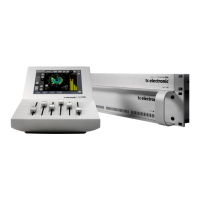118
lM6
and correlate well with human test panels. It therefore
seemsjustifiedtouseLeq(RLB)asabaselinemeasurefor
loudness, especially because room for improvement is also
built into the standard. The final BS.1770 standard included
a multichannel annex with a revised weighting filter, R2LB
–nowknownas“K”weighting-andachannelweighting
scheme. These two later additions have been less verified
than the basic Leq(RLB) frequency weighting.
The other aspect of BS.1770, the algorithm to measure
true-peak,isbuiltonsolidground.Inconsistentpeak
meter readings, unexpected overloads, distortion in
data reduced delivery and conversion etc. has been
extensivelydescribed,soinliaisonwithAESSC-02-01,an
over-sampledtrue-peaklevelmeasurewasincludedwith
BS.1770.
In conclusion, BS.1770 is an honorable attempt at
specifyingloudnessandpeaklevelseparately,instead
ofthesimplistic(samplepeak)andmixedupmeasures
(quasi-peak)inusetoday.Theloudnessandpeaklevel
measurement engine of LM6 follows the standard precisely.
PossibleupdatestotheITUstandardmaybereleasedas
LM6updates,providedthatprocessingrequirmentsdoesn’t
exhaust the system.
TechnicalpapersfromAES,SMPTE,NABandDAFX
conferences with more information about loudness
measurement,evaluationofloudnessmodels,true-peak
detection,consequencesof0dBFS+signalsetc.,are
available from the TC website. Visit the Tech Library at
www.tcelectronic.com/techlibrary.asp for details.
Meter Calibration
Because of the frequency and channel weighting, and
of the way channels sum, only specific tones and input
channels should be used for calibration.
Themosttransparentresultsareobtainedusinga1kHz
sine tone for calibration. Other frequencies or types of
signalmaybeused(squarewave,noiseetc.),butdon’t
expect similar results. The beauty of the system lies in
its RMS foundation, so this is a feature, not an error. The
same feature enables the loudness measure to identify
overlyhotCDsorcommercials,andtotakeoutofphase
signalsintoaccountjustasmuchassignalsthatarein
phase.
Ifwesticktostandardmethodsformeasuringpeakaudio
level in a digital system, where a sine wave (asynchronous
ofthesamplerate)withdigitalpeaksat0dBFS,is
regardeda0dBFStone,BS.1770andLM6outputthese
results:
Onefrontchannelfedwitha–20dBFS,1kHzsinetone=>
Readingof–23,0LUFS.
Twofrontchannelsfedwitha–20dBFS,1kHzsinetone
=>Readingof–20,0LUFS.
All5.1channelsfedwitha–20dBFS,1kHzsinetone=>
Readingof–15,4LUFS.
Level versus Loudness
When level normalization in audio distribution is based on a
peaklevelmeasure,itfavorslowdynamicrangesignatures
asshowninFig1.ThisiswhathashappenedtoCD.
Quasi-peaklevelmetershavethiseffect.Theytelllittle
about loudness, and also require a headroom in order
tostayclearofdistortion.UsingIEC268-18meters,the
headroomneededistypically8-9dB.
Sample based meters are also widely used, but tell even
less about loudness. Max sample detection is the general
rule in digital mixers and DAWs. The side effect of using
such a simplistic measure has become clear over the last
decade, and CD music production stands as a monument
over its deficiency. In numerous TC papers, it has been
demonstratedhowsamplebasedpeakmetersrequirea
headroom of at least 3 dB in order to prevent distortion and
listener fatigue.
The only type of standard level instrument that does not
displaysomesortofpeaklevelistheVUmeter.Though
developedforanotherera,thiskindofmeterisarguably
betteratpresentinganaudiosegment’scenterofgravity.
However,aVUmeterisnotperceptuallyoptimized,orideal
forlookingataudiowithmarkedlydifferentdynamicrange
signatures.
Unlikeelectricallevel,loudnessissubjective,andlisteners
weighitsmostimportantfactors-SPL,Frequencycontents
andDuration-differently.Insearchofan“objective”
loudness measure, a certain Between Listener Variability
(BLV) and Within Listener Variability (WLV) must be
accepted, meaning that even loudness assessments by
the same person are only consistent to some extent,
and depends on the time of day, her mood etc. BLV
adds further to the blur, when sex, culture, age etc. are
introduced as variables.
Because of the variations, a generic loudness measure
isonlymeaningfulwhenitisbasedonlargesubjective
reference tests and solid statistics. Together with McGill
UniversityinMontreal,TCElectronichasundertaken
extensive loudness model investigation and evaluation.
The results denounce a couple of Leq measures, namely
A and M weighted, as generic loudness measures. In fact,
aquasi-peakmetershowedbetterjudgementofloudness
thanLeq(A)orLeq(M).Evenusedjustforspeech,Leq(A)
isapoorpick,anditperformsworseonmusicandeffects.
An appropriate choice for a low complexity, generic
measurementalgorithm,whichworksforlisteninglevels
useddomestically,hasbeenknownasLeq(RLB).
Combinedloudnessandpeaklevelmetersexistalready,
for instance the ones from Dorroughs, but BS.1770 now
offers a standardized way of measuring these parameters.
In2006,ITU-RWorkingParty6Jdraftedanewloudness
andpeaklevelmeasure,BS.1770,andthestandard
has subsequently come into effect. It has been debated
if the loudness part is robust enough, because it will
obviously get exploited where possible. However, with a
variety of program material, Leq(RLB) has been verified in
independent studies to be a relatively accurate measure,

